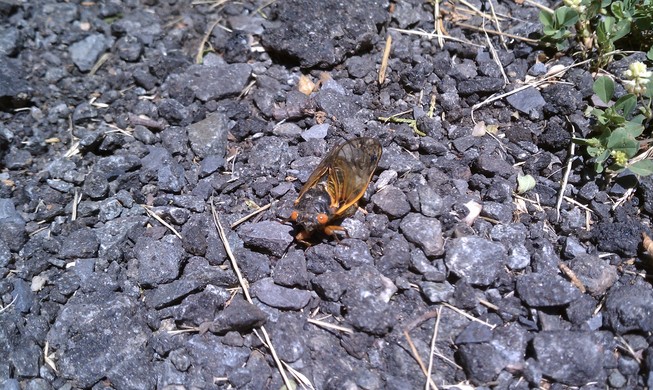As I sit, I listen to the buzz of a million ravenous, lustful insects. My usually peaceful neighborhood has been invaded by a swarm of black, red, and orange creatures who have emerged from the earth like zombies and have proceeded to lay claim to all before them. I speak, of course, of the periodical cicada.
This is Brood II, actually and it’s kind of a surreal experience. This is not the first time I’ve seem the cicada’s emerge in this area. The last time it happened, however, I was in highschool. (That was a different brood.) Simply sitting on my porch, I can’t actually see any cicadas aside from the occasional orange speck in the distance. The reason that the apartment complex I live in was built since the last time this brood emerged, seventeen years ago. I can still hear them however; their mating buzzes make for an ominous roar.
Across the parking lot, in the direction I’m facing is an old park dedicated to a Civil War site. In the small woods surrounding this park, the cicadas swarm in enormous numbers. They cover some of the trees and swarm back and forth. At night, they seem to congregate around street lamps and are even busier than during the day. So far they’ve been noisiest in the morning, and have been the first thing I’ve been hearing upon waking for the past few days.
The first one I saw was exactly one week ago. This was him:

One of the more interesting things about the periodical cicada is its life cycle. The insect hatch underground and live there for thirteen or seventeen years, before emerging in large numbers for only a short time to mate and restart the cycle. This is part of a tactic called “predator satiation,” which means that populations of predators which normally have to live without cicadas can only eat so many until they are full, so the vast majority of cicadas are left alone.
The curious thing is that the cicadas’ time underground, no matter the species or the brood, is always a prime number. This Brood spent seventeen years underground and was last seen in 1996. Prime numbers have a special property in mathematics, in that they naturally avoid the synchronization of cycles. For example, they are used in cryptography to generate keys and pseudorandom numbers. Two prime numbers can be used to create a sequence of evenly distributed, but seemingly random numbers by simply adding one prime number to the last generated number, modulo of another, larger prime number.
Another application of primes is in mechanics where gears and cogs are typically given prime numbers of teeth so that any two gears will not get into a rhythm with certain teeth meeting more than other teeth. This promotes much more even wear on the gears and makes them last longer. So for the cicadas, the seventeen year underground period, prevents their lifecycle from getting into sync with the lifecycle of a predator. When they emerge, they emerge unmolested and en-mass:
The cicadas will only be around for a few more weeks, so I’m taking pictures and videos while I can. I think I might take a sample as well, but am not sure of the best way to do that.